The case of Caracol
6th of 7 articles
Robert Etienne looks out with dismay at the fence cutting through his field in Fleury, near Caracol, in Haiti’s Northeast department. Earlier this year, he had a healthy crop of beans coming up through the rich, black soil.
“The first week of January, tractors moved across all this area and broke down everyone’s fences. Thieves and animals followed, and our crops were gone,” the septuagenarian told Haiti Grassroots Watch (HGW) during a June, 2011, visit.
Etienne brought up his four children right here, by raising animals and farming a small family-owned plot and a larger plot he leased from the state. Along with hundreds of other farmers in this community , he woke up one day last January to discover his fields had been destroyed.
Unbeknownst to Etienne and other farmers, that same week the Haitian government signed an agreement with US Secretary of State Hillary Clinton, representatives of the Inter-American Development Bank (IDB) and the Korean textile giant Sae-A Trading. With those signatures, Etienne’s land and about 300 other plots were converted into an industrial zone.
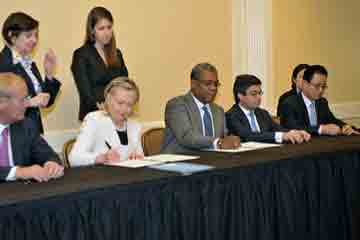
Signing the PIRN agreement, January 11, 2011. Photo: PIRN
“This will be the match that strikes a fire, and gets things going,” Hillary’s husband, former US President Bill Clinton, told the Wall Street Journal. Clinton, who at the time headed the Interim Haiti Recovery Commission (IHRC), has long-championed plans to bring more industry to Haiti.
But farmers like Etienne, along with labor leaders, environmentalists and economists, are all wondering – just what “fire” has been lit and when “things get going,” what “things,” and where will they “go?”
Also, why was Caracol chosen?
All parties agree that the site – which is part of the Trou du Nord River watershed – is one of the most fertile spots in the Northeast Department. The new industrial park will also be located only about five kilometers from a large bay which is home to one of the country’s last mangrove forests and extensive coral reefs.
In order to find out why Caracol was chosen, and to get a better picture of the potential “winners” and “losers” in the project, HGW visited the Northeast, reviewed a half-dozen studies, and interviewed numerous experts and potential beneficiaries.
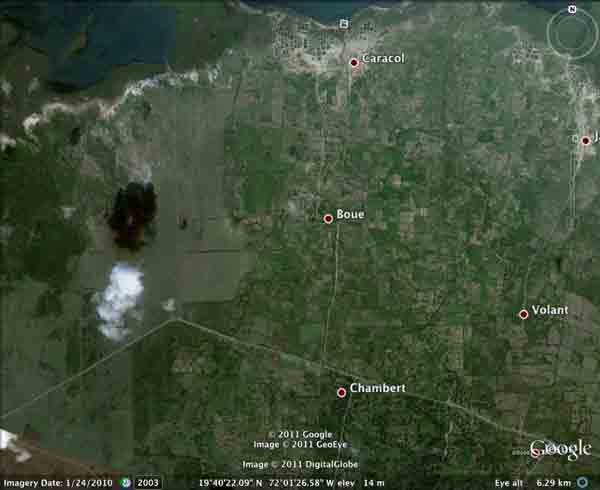
The PIRN is located between Chambert and Caracol.
PIRN - A public-private partnership
The Industrial Park of the North Region (Parc Industriel de la Région Nord - PIRN), which recently changed its name to the Parc Industriel de Caracol, is the showcase reconstruction project for the new government, the CIRH and the “international community” in Haiti – US, France, Canada, the European Union and the Inter-American Development Bank (IDB). The 243-hectare industrial park is slated to open in March, 2012. Planners say some 20,000 people will be hired for “Phase 1,” and that up to 100,000 new direct or indirect jobs, the overwhelming majority of them sweatshop wage-level assembly jobs, will be created over the next few years. [See Salaries in the “new” Haiti - Story 1]
In the planning stages before the earthquake, and with an initial price ticket of over US$200 million, the PIRN is the result of a “public-private partnership.” But the Government of Haiti (GOH) is not the only “public” partner.
The “public” to the north – US citizens – are the project’s biggest investor, providing some US$124 million in US tax dollars. That financing that will be used (according to project documents) to improve nearby port infrastructure, build a electricity plant to supply power to the PIRN, and build at least 5,000 units of housing.
As Bill Clinton implied, foreign investment is a key part of the economic plan he and the Haitian government are pushing [see Why is Haiti “attractive?” - Story 3]. Washington is doing everything it can to help assure Haiti is “open for business.” Thus, at a briefing on January 7, 2011, US AID Director Cheryl Mills was proud to report that her team had “been working through with foreign investors on how we could go about attracting them to an industrial park.”
In addition to US tax dollars, the PIRN is also being funded by the IDB to the tune of US$55 million. The IDB money will be used to build “factory shells and inside-the-fence infrastructure,” according to US State Department documents.
The use of taxpayer dollars to subsidize private business is nothing new. “Public Private Partnerships” (PPP) are common the world over. The taxpayers take risks to make a location or a sector attractive for private capital. And while the overall logic and justice of PPPs in general could certainly be debated, the specifics of this PPP really stand out. It goes further than most. It uses tax dollars – mostly from the US – to benefit textile and clothing companies that are not necessarily American, and every job created there will likely result lay-offs of workers in US.
Ultimately, in the case of the PIRN at least, US taxpayers are making it easier and cheaper for foreign and local clothing and textile companies firms to set up (sweat-)shops in Haiti, lay off better paid workers in the US and other countries, and increase their profits. [See What’s planned for Haiti? - Story 4] If Levis and the GAP can get their clothes stitched in a place that pays US$5.00 a day rather than US$9.00 an hour (approximately the lowest wage paid in US-based clothing factories), with new infrastructure, electricity, UN peacekeepers to provide security, and tax-free revenues and other benefits, why not?
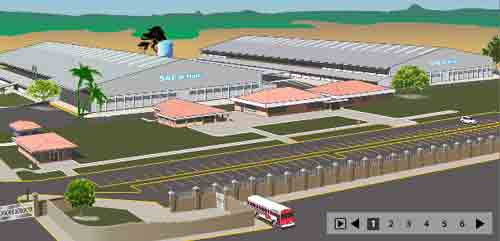
Architect's rendering of an Sae-A plant. From: PIRN website
Ironically, the main private partner in the PIRN is not Haitian or American. The partner is South Korean textile giant Sae-A Trading, which promises to spend US$78 million to build a 50,000 hectare factory complex that eventually employs 20,000 workers (in the first phase) and which will eventually include a textile mill that will do knitting and dyeing.
Sae-A Trading is one of the worlds larger apparel makers, supplying to GAP, Wal-Mart, Target and other major US retailers. The company has been building factories and textile mills around the world at record pace recently: Nicaragua, Indonesia, and now Haiti. One of the largest clothing manufacturers in the world, a 2009 article reporter that its exports – all to the US – were valued at about US$885 million.
“Our 20 factories worldwide produce 1.4 million pieces of clothing a day and the annual production rate is 360 million pieces,” founder Kim Woong-ki told the Korea JoongAng Daily. “That number is nearly equal to the U.S. population.
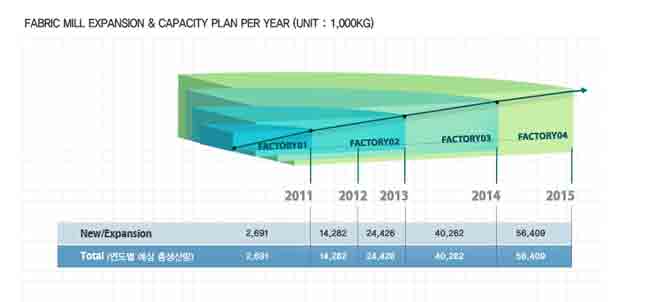
Image from Sae-A Trading Company's website.
But Sae-A Trading is not investing in Haiti to “create jobs,” as the fans of assembly industry based “sustainable development” – like President Michel Martelly – claim. The company is moving in to make more money. Sae-A will be in perfect position to take advantage the HELP Act – that allows textiles to enter the US from Haiti tariff-free [see Why is Haiti “attractive?” - Story 3], and then of the recently approved US-Korea Free Trade Agreement (KORUS FTA). Sae-A Trading is setting up shop just in time.
Approved by Congress in October, KORUS FTA – which could go into effect as early as January 1 – will immediately reduce tariffs on most Korean goods to zero, with more reductions coming in five and ten years. A 2007 study by the US International Trade Commission estimated the agreement “would likely result in a significant increase in bilateral U.S.-Korea trade in textiles and apparel, particularly U.S. imports from Korea.”
And therefore, most likely, a further decrease in employment in the US textile and apparel sector.
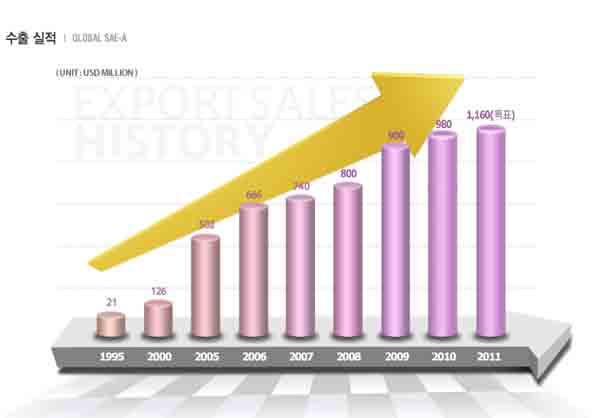
Image from Sae-A Trading Company's website.
How was Caracol chosen?
Even before the earthquake, the GOH and its supporters targeted the north of Haiti for an industrial park because of its proximity to the US and to the Dominican Republic. According to various government and consultant documents, a good site needs access to a large unemployed population, an abundant water supply, electricity, and major highways.
The US-based Koios Associates consulting firm, hired to help choose a site, also noted that the north region was a great place because “the area has large stretches of relative empty land.”
Of course, “relatively empty” is a relative term, as will be shown below.
The Koios study – dated September 20, 2010 – recommended 18 possible sites, with the Caracol site ranked #2 of 18.
“The river to the east of the site has substantial perennial flow and is likely to be suitable for factories using substantial water and requiring discharge of treated water. The land is devoid of habitation and intensive cultivation,” the report stated.
Except, it wasn’t quite “devoid.” The Caracol site was home to 300 farming plots.
But the site was chosen anyway. According to a subsequent Koios study – dated May, 2011, and entitled “Study of the Environmental and Social Impacts: Industrial Park of the North Region of Haiti”i – the Caracol site was selected by the GOH because:
• of the Trou du Nord River - “it is capable of absorbing a large volume of treated water,”
• of an abundant subterranean water supply,
• most of the land belongs to the State, meaning that it would be easier to kick off the farmers.
“Good agricultural lands”
In their second study Koios admitted that the site was actually home to “good agricultural lands.” But it was too late by then. Farmers had been evicted and a fence put up.
Asked after the fact by the Ministry of Environment (MOE), Caracol Mayor Colas Landry said he disagreed with the choice of the spot.
“If I were consulted by the project promoters, I would never propose that site. I would orient them to Madras,” he told the MOE in an internal report leaked to HGW.
(According to Haiti’s Free Trade Zone Office, Free Trade and Industrial Zones should not be set up on farming land. In an interview with HGW, the Office’s Luc Especca insisted on the point, saying “We all remember what happened with CODEVI.” The CODEVI Free Trade Zone, built on the fertile Maribahoux Plain, caused considerable upheaval and protests in Haiti and internationally.)
What about the environment?
Shockingly, the second Koios study also admitted that “the study process and the section of sites was not accompanied by extensive environmental, hydrologic or topographic research.” [our italics]
Indeed, a the comprehensive internal MOE reportii obtained by HGW confirmed that, noting that “at [no] moment the MOE was associated in any thought in the identification of the site Caracol.”
The report – subtitled “To what extent and under what prerequisite a win-win situation could be envisaged from an environmental point of view?” – also noted that the PIRN could have “great potential adverse impact on the environment.”
Apparently, the Koios team agreed.
When the firm took a closer look at the site in its second study this past spring, it suggested the GOH change the “risk rating” for the project from B, or “medium,” to A which – according to the MOE document – means “significant adverse environmental impacts.”
In addition, Koios noted that a more detailed environmental and social impact would be necessary. The consultants suggested that while the more thorough study is conducted, the GOH should “impose certain limits to the industrial activities authorized in the park during the first 12 to 24 months of operations.”
Koios also noted that the region is also home to the significant indigenous archeological sites, and some of earliest European settlements in the hemisphere. The firm went so far as to make two other, even more radical, suggestions:
1 - Move the project to another site in the north or even a completely different region of Haiti, or
2 - Cancel the project, although, the consultants remarked, “[i]t’s cancellation could call into question the reputation of the parties concerned and could harm the reputation of Haiti as a country that welcomes investment.”
Not surprisingly, the PIRN was neither moved nor cancelled…
And, two months after the Koios report came out, perhaps seeking to downplay the environmental aspect, the Ministry of Economy and Finance bought several one-page ads in Le Nouvelliste where it reported that “environment issues have been considered with a great deal of attention” and claimed that more studies were underway. And, a month later, the IDB’s Eduardo Almeida said everything was ready to move forward since “[e]nvironmental impact studies… have already been completed in the region.”
Indeed, the project is moving forward.
On November 28, the major actors flew to Caracol to inaugurate the site. Clinton, Martelly, Sae-A Trading, the BID – they were all there.
“Haiti is open for business,” Martelly said as he stood in front of a giant architect’s schematic drawing of the factory zone. “This is the kind of change we need.”
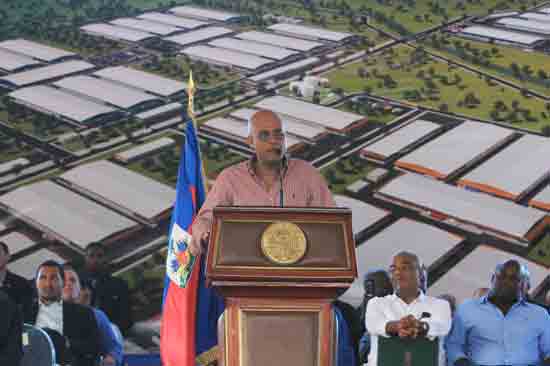
President Michel Martelly saying Haiti is "open for business" at the
November 28 inauguration. Photo: Martelly Facebook page
But what about the risks identified by Koios and the Ministry of the Environment?
Are more studies taking place or not?
Will limits be imposed on the PIRN’s tenants during the first 12 to 24 months?
How did the Ministry of Economy and Finance – the main ministry shepherding the PIRN and the one that commissioned the Koios study – react to the Koios recommendations and the MOE report?
For more, read the final story, #7, in our series – Industrial Park in Caracol: A "win-win" situation?
Return to the Introduction and the video
i. More than a few observers – including the current Minister of the Environment – have criticized the fact that the first and second study were conducted by the same firm.
ii. In English, with considerable errors. Therefore, citations may have some corrections in brackets.


